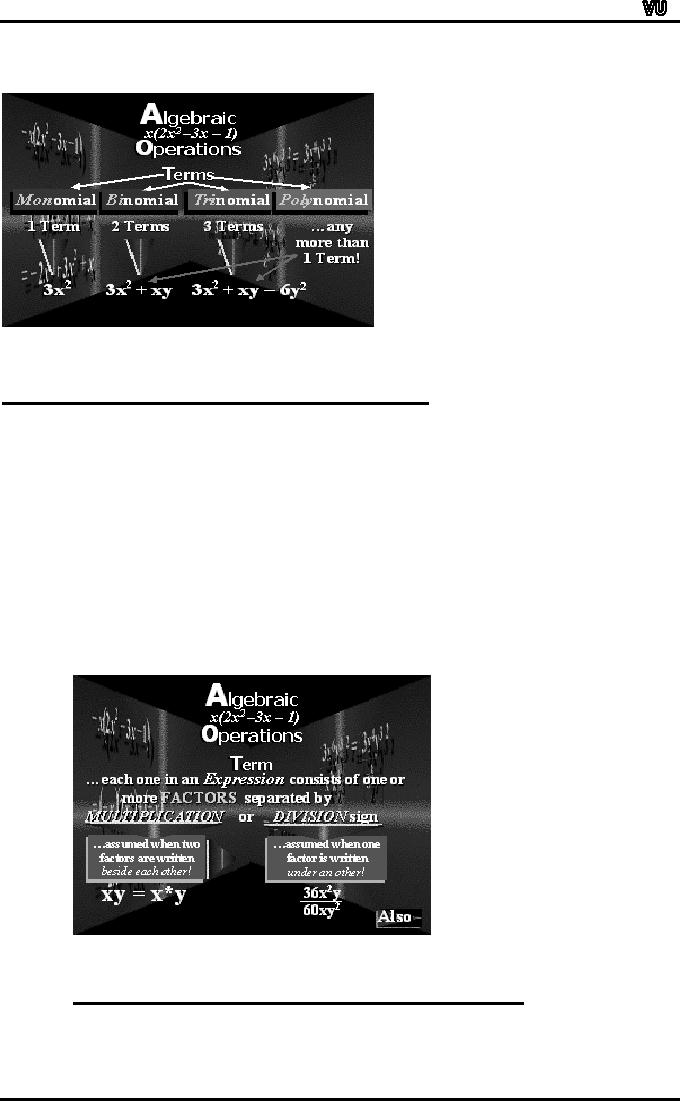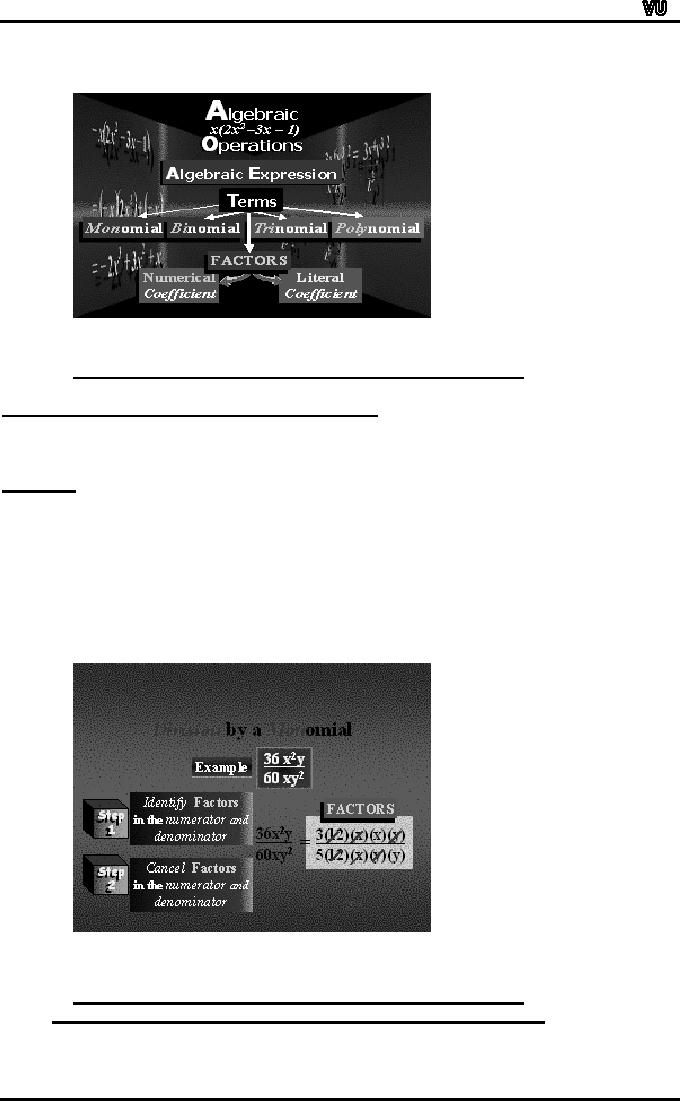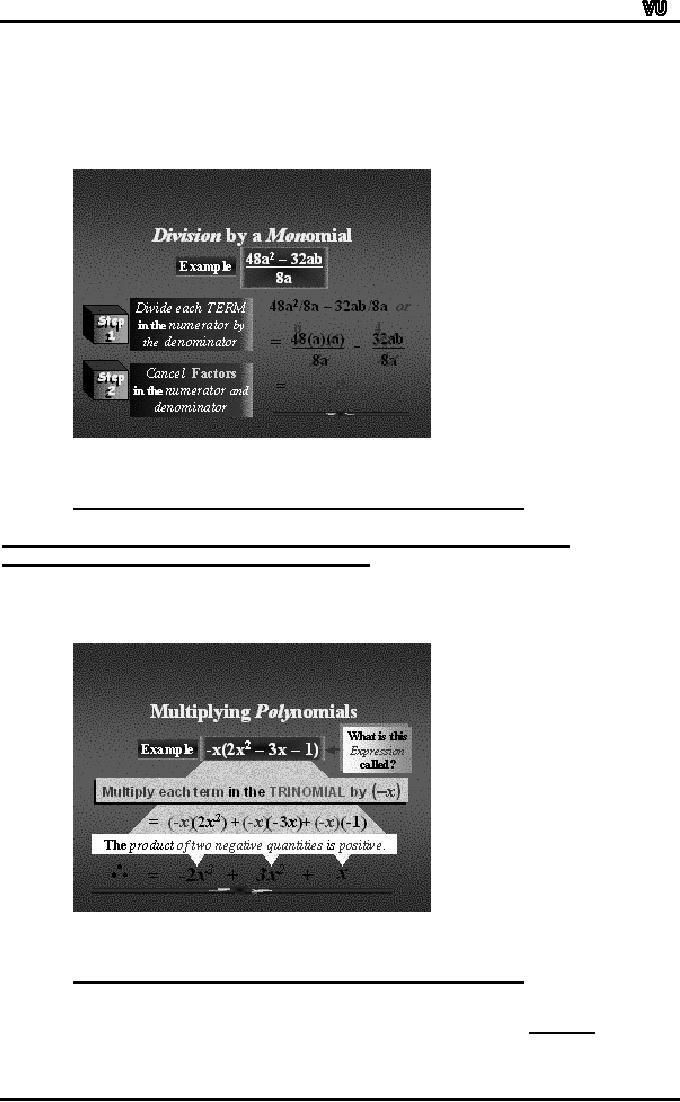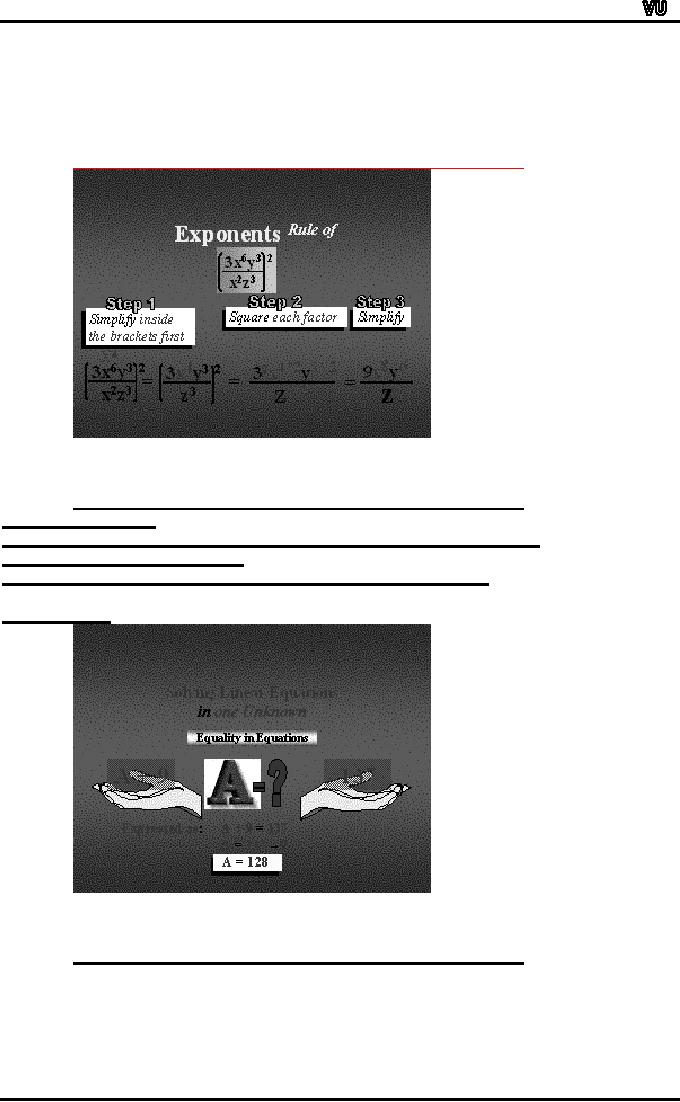 |
Applications of Basic Mathematics:NOTATIONS, ACCUMULATED VALUE |
| << Applications of Basic Mathematics Part 5:DECREASE IN RATE |
| Matrix and its dimension Types of matrix:TYPICAL APPLICATIONS >> |

MTH001
Elementary Mathematics
LECTURE #
18
Applications of
Basic Mathematics
OBJECTIVES
The
objectives of the lecture
are to learn about:
�
Scope
of Module 2
�
Annuity
�
Accumulated
value
�
Accumulation
Factor
�
Discount
Factor
�
Discounted
value
�
Algebraic
operations
�
Exponents
�
Solving
Linear equations
Annuity
Let
us look at an example to understand
what is annuity.
Suppose
that
you want to buy electric
equipment on installments. The
value of the
equipment
is Rs. 4,000. The company
informs you that you
must pay Rs.
1,000
at
the time of purchase (down
payment = 1,000). The rest
of the payments are
to
be
made in 20 installments of 200
rupees each. You are
wondering about
the
total
number and sequence of
periodic payments. The
sequence of payments at
equal
interval of time is called
Annuity. The time between
payments is called
the
Time
Interval.
NOTATIONS
The
following notations are used
in calculations of Annuity:
R
= Amount of annuity
N
= Number of payments
I
= Interest rater per
conversion period
S
= Accumulated value
A
= Discounted or present worth of an
annuity
ACCUMULATED
VALUE
The
accumulated value S of an annuity is
the total payments
made
including
the interest. The formula
for Accumulated Value S is as
follows:
S
= r ((1+i)^n 1)/i
Accumulation
factor for n payments = ((1
+ i)^n 1) / i
It
may be seen that:
Accumulated
value = Payment per period x
Accumulation factor for n
payments
The
discounted or present worth of an
annuity is the value in
today's rupee
value.
As an example if we deposit 100
rupees and get 110 rupees
(100 x 1.1)
after
one year, the Present
Worth of 110 rupees will be
100. Here 110 will
be
future
value of 100 at the end of
year 1. The amount 110, if
invested again,
can
be
Rs. 121 after year 2.
The present value of Rs.
121, at the end of year 2,
will
also
be 100. Thus, the total
present worth of payments
made in year 1 and
2
(100+110
= 210) will be 200. The
Future Value of this present
worth is 210.
(110x1.1)
DISCOUNT
FACTOR AND DISCOUNTED VALUE
When
future value is converted
into present worth, the
rate
at
which the calculations are
made is called Discount
rate. In the
previous
example
10% was used to make the
calculations. This rate is
called Discount
Page
122

MTH001
Elementary Mathematics
Rate.
The present worth of future
payments is called Discounted
Value. The
above
example may be restated as
follows:
The
future value of Annuity in
year 1 and 2 is 100 and 110
respectively. The
Discount
rate is 10%. The
Accumulation Factor after
year 1 is 100+(10/100) =
100.1.
The Accumulation Factor
after year 2 will be
110+11/100=1.21.
The
Accumulation Factor can also
be calculated by treating the
value at the end
of
year 1 as 1 plus interest on 1.
After year 1, the
Accumulation Factor will
be
1+0.1=1.1.
Here we treated 10% of 1 as
0.1.
Obviously
the Discounted Value at the
beginning of year 1 can be
calculated as
(1+0.1)/1.1
=1. Here 1/1.1=0.9 is the
Discount Factor. If you
multiply the
Future
Value
or Payment in year 2 (1.1) by
the Discount Factor (0.9),
you get the
discounted
value (1.1 x 0.9 =
1).
Thus,
we can write down the
formula for Discounted Value
as follows:
Discounted
value= Payment per period x
Discount factor
The
formula can be written as
follows:
A
= r ((1- 1/(1+i)^n)/i)
EXAMPLE
1. ACCUMULATION FACTOR (AF)
FOR n PAYMENTS
Calculate
Accumulation Factor and
Accumulated value
when:
t
rate of interest i = 4.25
%
Number
of periods n = 18
Amount
of Annuity R = 10,000
Rs.
Accumulation
Factor AF = ((1 + 0.0425)^18-1)/0.0425 =
26.24
Accumulated
Value S = 10,000x 26.24 =
260,240 Rs
EXAMPLE
2. DISCOUNTED VALUE
(DV)
In
the above example calculate
the value of all payments at
the beginning of
term
of annuity i-e present value
or discounted value.
Discount
rate = 4.25%
Number
of periods = 18
Amount
of annuity= 10000 Rs
Value
of all payments at the
beginning of term of Annuity or
discounted value
=
Payment per period x
Discount Factor
(DF)
Formula
for Discount Factor =
((1-1/(1+i)^n)/i)
=
((1-1/(1+0.0425)^18))/0.0425) =
12.4059
=
6.595
Discounted
value = 10000 � 12.4059 =
124059 Rs
EXAMPLE
3. ACCUMULATED VALUE
(S)
How
much money deposited now
will provide payments of Rs.
2000 at the end
of
each
half-year for 10 years if
interest is 11% compounded
six-monthly.
Amount
of annuity = 2000Rs
Rate
of interest = i = 11% / 2 =
0.055
Number
of periods = n = 10 � 2 = 20
calculate
the Accumulated Value
S.
ACCUMULATED
VALUE = 2,000 x ((1-1 /
(1+0.055)^20) / 0.055)
=
2,000 x11.95
=23,900.77
ALGEBRAIC
OPERATIONS
Algebraic
Expression indicates the
mathematical operations to be carried
out on
a
combination
of NUMBERS and
VARIABLES.
The
components of an algebraic expression
are separated by Addition
and
Subtraction.
Page
123

MTH001
Elementary Mathematics
In
the expression 2x2
3x -1 the components 2x2, 3x
and 1 are separated
by
minus
"-" sign.
In
algebraic expressions there
are four types of
terms:
Monomial,
i.e. 1 term (Example:
3x2)
�
Binomial,
i.e. 2 terms (Example:
3x2+xy)
�
Trinomial,
i.e. 3 terms (Example:
3x2+xy-6y2)
�
�
Polynomial,
i.e. more than 1 term
(Binomial and trinomial
examples are
also
polynomial)
Algebraic
operations in an expression consist of
one or more FACTORs
separated
by MULTIPLICATION or DIVISION
sign.
Multiplication
is assumed when two factors
are written beside each
other.
Example:
xy = x*y
Division
is assumed when one factor
is written under an
other.
Example:
36x2y
/ 60xy2
Factors
can be further subdivided
into NUMERICAL and LITERAL
coefficients.
Page
124

MTH001
Elementary Mathematics
There
are two steps for
Division by a monomial.
1.
Identify
factors in the numerator and
denominator
2.
Cancel
factors in the numerator and
denominator
Example:
36x2y /
60xy2
36
can be factored as 3 x
12.
60
can be factored as 5 x 12
x2y
can be factored as
(x)(x)(y)
xy2 can be factored as
(x)(y)(y)
Thus
the expression is converted
to: 3 x 12(x)(x)(y)/ 5 x
12(x)(y)(y)
12x(x)(y)
in both numerator and
denominator cancel each
other. The result
is:
3(x)/5(y)
Another
example of division by a monomial is
(48a2
32ab)/8a.
Here
the steps are:
1.
Divide
each term in the numerator
by the denominator
Page
125

MTH001
Elementary Mathematics
2.
Cancel
factors in the numerator and
denominator
48a2 / 8a =
8x6(a)(a) / 8a = 6(a)
32(a)(b)
/ 8(a) = 4x8(a)(b) / 8(a) =
4(b)
The
answer is 6(a)
4(b).
How
to multiply polynomials? Look at
the example
x(2x2
3x -1). Here each
term
in the trinomial 2x2
3x -1 is multiplied by x.
=
(-x)(2x2)
+ (-x)(-3x) + (-x)(-1)
=
-2x3+
3x2
+x
Please
note that product of two
negatives is positive.
(3x6y3 /
x2z3)2
Exponent
of a term means calculating
some power of that term. In
the following
example
we are required to work out
exponent of 3x6y3 /
x2z3 to the power of
2.
The
steps in this calculation
are:
Page
126

MTH001
Elementary Mathematics
1.
Simplify
inside the brackets
first.
2.
Square
each factor
3.
Simplify
In
the first step, the
expression 3x6y3 /
x2z3 is first
simplified to (3x4)(y3)/z3.
In
the next step we take
squares. The resulting
expression is: (32)(x4*2)(y3*2)/z3*2 =
9x8 y6 /z6
LINEAR
EQUATION
If
there is an expression A + 9 = 137, how
do we calculate the value of
A?
A
= 137 9 = 128
As
you see the term 9 was
shifted to the right of the
equality.
To
solve linear
equations:
1.
Collect
like terms
2.
Divide
both sides by numerical
coefficient.
Step
1: x = 341.25 + 0.025x
x
0.025x = 341.25
Page
127

MTH001
Elementary Mathematics
x(1-0.025)
= 341.25
0.975x
= 341.25
Step
2.
x
= 341.25/0.975 = 350
Page
128
Table of Contents:
- Recommended Books:Set of Integers, SYMBOLIC REPRESENTATION
- Truth Tables for:DE MORGAN’S LAWS, TAUTOLOGY
- APPLYING LAWS OF LOGIC:TRANSLATING ENGLISH SENTENCES TO SYMBOLS
- BICONDITIONAL:LOGICAL EQUIVALENCE INVOLVING BICONDITIONAL
- BICONDITIONAL:ARGUMENT, VALID AND INVALID ARGUMENT
- BICONDITIONAL:TABULAR FORM, SUBSET, EQUAL SETS
- BICONDITIONAL:UNION, VENN DIAGRAM FOR UNION
- ORDERED PAIR:BINARY RELATION, BINARY RELATION
- REFLEXIVE RELATION:SYMMETRIC RELATION, TRANSITIVE RELATION
- REFLEXIVE RELATION:IRREFLEXIVE RELATION, ANTISYMMETRIC RELATION
- RELATIONS AND FUNCTIONS:FUNCTIONS AND NONFUNCTIONS
- INJECTIVE FUNCTION or ONE-TO-ONE FUNCTION:FUNCTION NOT ONTO
- SEQUENCE:ARITHMETIC SEQUENCE, GEOMETRIC SEQUENCE:
- SERIES:SUMMATION NOTATION, COMPUTING SUMMATIONS:
- Applications of Basic Mathematics Part 1:BASIC ARITHMETIC OPERATIONS
- Applications of Basic Mathematics Part 4:PERCENTAGE CHANGE
- Applications of Basic Mathematics Part 5:DECREASE IN RATE
- Applications of Basic Mathematics:NOTATIONS, ACCUMULATED VALUE
- Matrix and its dimension Types of matrix:TYPICAL APPLICATIONS
- MATRICES:Matrix Representation, ADDITION AND SUBTRACTION OF MATRICES
- RATIO AND PROPORTION MERCHANDISING:Punch recipe, PROPORTION
- WHAT IS STATISTICS?:CHARACTERISTICS OF THE SCIENCE OF STATISTICS
- WHAT IS STATISTICS?:COMPONENT BAR CHAR, MULTIPLE BAR CHART
- WHAT IS STATISTICS?:DESIRABLE PROPERTIES OF THE MODE, THE ARITHMETIC MEAN
- Median in Case of a Frequency Distribution of a Continuous Variable
- GEOMETRIC MEAN:HARMONIC MEAN, MID-QUARTILE RANGE
- GEOMETRIC MEAN:Number of Pupils, QUARTILE DEVIATION:
- GEOMETRIC MEAN:MEAN DEVIATION FOR GROUPED DATA
- COUNTING RULES:RULE OF PERMUTATION, RULE OF COMBINATION
- Definitions of Probability:MUTUALLY EXCLUSIVE EVENTS, Venn Diagram
- THE RELATIVE FREQUENCY DEFINITION OF PROBABILITY:ADDITION LAW
- THE RELATIVE FREQUENCY DEFINITION OF PROBABILITY:INDEPENDENT EVENTS